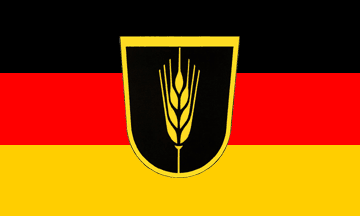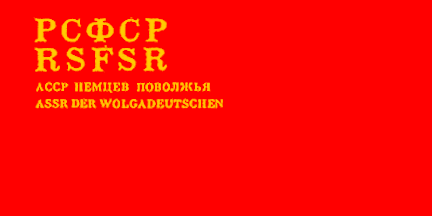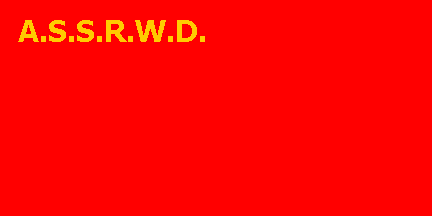
image by Jens Pattke, 09 April 2014

Last modified: 2021-08-26 by rob raeside
Keywords: volga german assr | assr der wolga deutschen |
Links: FOTW homepage |
search |
disclaimer and copyright |
write us |
mirrors

The Volga German ASSR existed 1924-1941: Established as Labour Commune
of Volga Germans or Volga German AO within Russian
SFSR on 19 october 1918. Transformed into Volga German ASSR on 19
december 1924. Abolished on 28 august 1941.
Mark Sensen, 11 Nov 1996
The official state name was: Autonome Sozialistische
Sowjet-Republik der Wolga-Deutschen (in
English: Autonomous Socialist Soviet Republic of the Volga-Germans);
abbreviation: «A.S.S.R.W.D.». In Russian: Avtonomnaâ
Sovetskaâ Socialistiĉeskaâ Respublika Nemcëv
Povolẑhâ |
Автономная
Советская
Социалистическая
Республика
Немцёв
Поволжья
Jens Pattke, 23 Jun 2001
The city of Engels is the former capital
of Volga-German Republic.
Victor Lomantsov, 07 Oct 2000
The first Germans settled the region starting in 1763 at the invitation of Catharine the Great. Three webpages with summary histories of the Volga germans are:
Some informations, I found in: Rudolf A. Mark Die Völker der ehemaligen Sowjetunion, 1992:
2,039 million Germans were living in former Soviet Union in 1992. Half of them are living in Kasachstan. The rest is scattered around in all the other states of the former Union. Nearly all are the descendants of settlers from Hesse, Palatinate, northern Bavaria and the Rhineland, which moved into the Russian Empire in the second half of the 18th century. The first big treks followed the call of Katharina II of Russia in 1762 and 1763. They arrived at the Volga in the area of Saratow in the same decade. In the following decades, other settlers from Danzig and West Prussia entered into the areas between Dnjeper river, the southern part of Bug river and the coast of the Black Sea. Germans from Württemberg, Alsace and other regions followed. Other German settlements were founded after Russian conquer in Northern Kaukasus. More in Bessarabia (Moldova) after 1812 between Dnjestr and Pruth.
The Area of the Germans at the Volga were declared to a German workers community in Okt.1918 after revolution, in Feb.1924 it got the status of an ASSR (autonom socialistic soviet republic) of the Volga Germans with the capital of Engels (1929: 27.152 km²). The ASSR had 600 000 inhabitants in 1939, 2/3 were Germans. Further, there were 16 national counties evrywhere in the USSR, 8 of them in the Ukraine. All were eliminated in 1939.
After 1941 and the German attack to USSR, 1 million of 1,5 million Germans in USSR were deported to Western Sibiria, Kasachstan, Kigisia, Tadshikistan and the Altai area. 300 000 of them died and 100 000 were sent into the working army (Trudarmija) till 1947. The Germans in the occupied areas were called to police like organizations, some were settled in the Wartheland. When Red Army striked back, many Volksdeutsche moved in direction of Germany in big and small treks. They were gathering most time outside of the borders of the German Reich and were deported to Sibiria and central Asia by red army in 1945. The deported Germans were kept in working camps till 1950, and were not allowed to move back to their old settlments.
Germans got full civil rights back in Nov 1972. In 1991 Germans got special national rights in the Altai area (German Rajon) at the city Halbstadt. Some Germans are resettled in Ukraine near Odessa, Cherson, Nikolajew and Saporoschje. Many hundred thousands Germans came back to the Federal Republic of Germany since the 1970ies.
J. Patrick Fischer, 28 Feb 2002

First known flag of the republic was adopted in 1926, red flag with
golden letters (abbreviation of the name of state) in german.
Victor Lomantsov, 07 Oct 2000
The first flag was adopted togheter the decree of fundation
of the republic 19 December 1924 and was red with inscription.
This flag was in use until adoption of new
constitution 29 April 1937. (Source:
personal communication from Lucien
Philippe; his source was personal communication from
Ottfried Neubecker, 1973).
Jaume Ollé, 03 Jul 2003

Adopted in 1937 (or in 1938), red with insciptions in Russian
and in German: "RSFSR. ASSR of Volga-germans".
Victor Lomantsov, 07 Oct 2000
[Flag version with German text above Russian text.]
According a document in the public library Pompidou in Paris [*], new flag
was adopted in 29 April 1937. William Crampton
obtained the exact design and comunicate it to
Philippe in August 1974. Was in use at least
until 1938. The flag in real use was slighty changed in
next months changing order of the inscriptions (russian first). (Source:
personal communication from Lucien Philippe.)
Jaume Ollé, 03 Jul 2003
(* Bibliothéque Publique d’Information, located in the
Centre National d’Art et Culture Georges-Pompidou, in Paris.)
Ivan Sache, 04 Jul 2003
Oleg Tarnowski communicated that the modified version
dated 1939, in use until 28 August 1941 (personal communication from
Lucien Philippe).
Jaume Ollé, 03 Jul 2003
No. I do not think, that it is the real information. In the State Historical
Archive of Volga Germans in the Engels-city (where I live), in documents of
the Supreme Council and of the Council of People’s Commissioners of
the Volga Germans ASSR and in newspapers of ASSRdWD of 1937-1941 there is no
document on change of a flag of 1937 of ASSRdWD. Absolutely authentically.
Mikhail Revnivtsev, 25 Oct 2006
On flags of autonomous republics (ASSR) in structure of the
RSFSR there could not be inscriptions on the
national languages located above of inscriptions
in Russian language. Absolutely authentically.
Mikhail Revnivtsev, 25 Oct 2006

image by Jens Pattke, 09 April 2014
This flag was posted by Ronald-Jan Rieger as a quiz on FOTW-fb and identified
as "Volga Germans community flag". The implication is that is used by the people
today.
"Territorial Association of the Russian Germans"
shows a flag with the same shield.
Rob Raeside, 06 April 2014
The Volga Germans (Wolgadeutsche) were Germans living along the Volga River
in Russia. As immigrants to Russia in the 18th century they kept their culture,
language, traditions, and Lutheran and Catholic churches. Many Volga Germans
later emigrated to the North and South Dakota and other western states as far
south as Kansas to escape persecution. Others immigrated to Canada, Argentina,
Paraguay, and Brazil. During World War II, the Soviet government considered the
Volga Germans undesirables and sent them to work camps in Siberia and other
points east to die. After the war years, many of the remaining Volga Germans
moved from the Soviet Union back to Germany.
This flag is shown as the national flag of the living descendants of Volga
Germans living in Russia and Middle Asia. See:
http://www.flaggenlexikon.de/fwolgadt.htm
According to this website: "The flag of the Volga Germans is a more recent
creation It has nothing to do with the flag of the former Soviet Republic
of the Volga Germans. It shows the colours of Germany, three horizontal
stripes in black, red and gold, and in the center a golden bordered black
scutcheon with a golden wheat in the middle. The flag embodies the German
nationality, and the rural working and living way, followed by the majority of
the Volga Germans."
Pete Loeser, 07 April 2014
Correct present flag is published http://www.vexillographia.ru/flags/Flag15.pdf
(in Russian).
Jens Pattke, 08 April 2014
The Territorial Association of the Germans from
Russia (LMDR) is an organization that represents the interests of
Germans who were expelled from countries of the former
Soviet Union, such as Altay,
Kazakhstan, Uzbekistan, and
Turkmenistan, and immigrated back to Germany in the
decades following the Second World War. The Territorial Association was founded
in August of 1955. It replaced the "Arbeitsgruppe der Ost-Umsiedler" (Club
of the Eastern Ethnic Resettlers) whose membership first consisted of Russian
emigrants living in Western Europe in exile. (Former Russian nobility,
anti-communists, monarchists, former prisoners of the Russian "Vlasov" Army,
Tatars and Caucasians, who served in the Wehrmacht, and fell into Western Allied
hands).
The mid-1970s saw the first Volga German exiles from the Soviet Union arrive in
numbers in both the Federal Republic of Germany and in the German Democratic
Republic. With this increased presence the Territorial Association of Germans
from Russia was turned into a political homeland association. In the 1990s, this
organization expanded its goals. It supported the efforts of the Germans from
Russia (and Kazakhstan, Uzbekistan, Turkmenistan), to integrate into German
society. These settlers had great pride in their German ethnic origins, but they
also valued their Russian traditions. Later many Russian Jews who immigrated to
Germany also found a new home in the Territorial Association, joining not for
religious reasons, but from longing for their old country in the former Soviet
Union.
The actual colors of the Territorial Association flag
was black-white-yellow. The organization's coat-of-arms was placed in the
center. The coat-of-arms shows a golden ear of corn on a black background. The
coat-of-arms symbolizes the Chernozem (Black Dirt) of the old country in the
Volga Territory. In the mid-1990s, the flag's stripes were placed in the color
sequence of the Russian Empire. The colors black, white and yellow were
reminiscent of the Empress Catherine II (Catherine the Great), who came from
Germany. She encouraged many Germans to settle in the
fertile region on the Volga River. This territory included
Kazakhstan, Uzbekistan, and
Turkmenistan, which later became part of the Soviet Union.
The modern flag with the coat-of-arms of the Territorial Association and the
German colors, black-red-gold, is actually a decorative composition, but some
local groups of the Territorial Association are using it as a flag variant. It
is not an official flag of the Territorial Association
of the Germans from Russia/Landsmannschaft der Deutschen von Russland
(LMDR).
Above image is a decorative composition of a flag of the Volga Germans ethnic
group; no official use of the "flag".
References:
http://www.lmdr.de
http://de.wikipedia.org/wiki/Landsmannschaft_der_Deutschen_aus_Russland
http://www.vexillographia.ru/flags/Flag15.pdf
Flaggenkurier Nr. 22
References (Fotos):
http://www.lmr-nrw.com/
http://www.udvhessen.de/archiv/2010/01/100118_deutscheausrussland.htm
http://www.lmdr-hannover.de/ueberuns.html
Jens Pattke, 09 April 2014